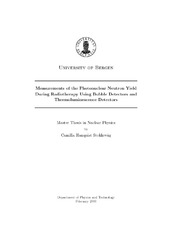| dc.contributor.author | Stokkevåg, Camilla Hanquist | eng |
| dc.date.accessioned | 2011-06-03T13:39:47Z | |
| dc.date.available | 2011-06-03T13:39:47Z | |
| dc.date.issued | 2010-02-22 | eng |
| dc.identifier.uri | https://hdl.handle.net/1956/4784 | |
| dc.description.abstract | Medical linear accelerators (linacs) used for radiotherapy with photons produce an undesirable neutron contribution as treatment energies exceed the (γ,n) threshold of the high-Z constituents of the linac. Secondary neutrons in radiotherapy contribute to additional dose outside the treatment volume in the patient. Treatment techniques offering improved confinement of the dose to the target volume are rapidly evolving and will contribute differently to the production of neutron doses outside the volume at target. The intention in this work has been two-fold: (1) Investigation of the characteristics and the responses of the detectors applied. (2) Measurements of the secondary neutron yield outside the treatment volume of a 15 MV photon beam produced by a Varian 23iX medical linac at Haukeland University Hospital (HUS). Neutron yields measured from the treatment techniques Three-Dimensional Conventional Radiation Therapy (3D-CRT) are compared to Intensity Modulated Radiation Therapy (IMRT). The neutron measurements were performed using bubble detectors and Thermoluminescence Detectors (TLDs). The TLD-600 is photon and thermal neutron sensitive, and the TLD-700 is photon sensitive. Pairs of TLDs were applied together in order to discriminate against the photon component of the mixed field. The bubble detectors employed were the Bubble Detector Spectrometer (BDS) used for obtaining information of the neutron energy spectrum, and the Bubble Detector Thermal (BDT) sensitive to thermal neutrons only. The response of the detectors was also measured in a mixed photon thermal-neutron field of the nuclear reactor at Institute for Energy Technology (IFE) at Kjeller (Norway). The BDS detectors were found to be sensitive in this field, either to neutrons with lower energy than the discrimination thresholds given from the vendor or to the photon component of the field. The BDT sensitivity measured in this field was four times higher than the calibrated sensitivity supplied by the manufacturer. The TLDs applied in the reactor field revealed a strong photon background, which made reliable photon discrimination in the TLD signal a challenge. The spatial distribution of the neutrons produced by the medical linac was also measured outside the target volume with TLDs positioned in a plastic phantom. The neutrons were principally detected in the outer layers of the phantom, close to the linac head where the neutrons are produced. Two dose plans were created (in the Eclipse treatment planning system) in order to compare the neutron yield during the IMRT and 3D-CRT treatment techniques. Measurements were performed during delivery of the plans in a solid state plastic phantom, with TLD and BDS detectors situated outside the primary photon fields. The IMRT dose plan resulted in a higher neutron dose than the dose produced during 3D-CRT. The ratio of the neutron dose produced during the delivery of the two plans scales roughly with the ratio of the radiation output of the linac; the Monitor Units (MUs). The neutron fluences measured were 107 n/cm² per treatment Gy delivered to the target volume. For a full treatment of 70 Gy, the additional neutron doses were 0.2±0.1 Sv for 3D-CRT and 0.4±0.3 Sv IMRT. Two characteristic features of the neutron energy spectrum were observed; the low energy continuous distribution from neutron evaporation processes and a rather distinct peak from direct neutron knock-out processes. The sensitivity of the detectors to neutron energies, and potentially to photons, should be further investigated with respect to the correspondence between the response to fluence and dose. To obtain further information of the neutron energy spectrum, the use of TLDs with moderators of different sizes can be an alternative method. | en_US |
| dc.language.iso | eng | eng |
| dc.publisher | The University of Bergen | en_US |
| dc.title | Measurements of the Photonuclear Neutron Yield During Radiotherapy Using Bubble Detectors and Thermoluminescence Detectors | en_US |
| dc.type | Master thesis | |
| dc.rights.holder | The author | en_US |
| dc.rights.holder | Copyright the author. All rights reserved | en_US |
| dc.description.degree | Master i Anvendt og beregningsorientert matematikk | en_US |
| dc.description.localcode | MAMN-FYKJR | |
| dc.description.localcode | PHYSKJFYS | |
| dc.subject.nus | 752199 | eng |
| dc.subject.nsi | VDP::Mathematics and natural science: 400::Physics: 430::Nuclear and elementary particle physics: 431 | en_US |
| fs.subjectcode | PHYSKJFYS | |
